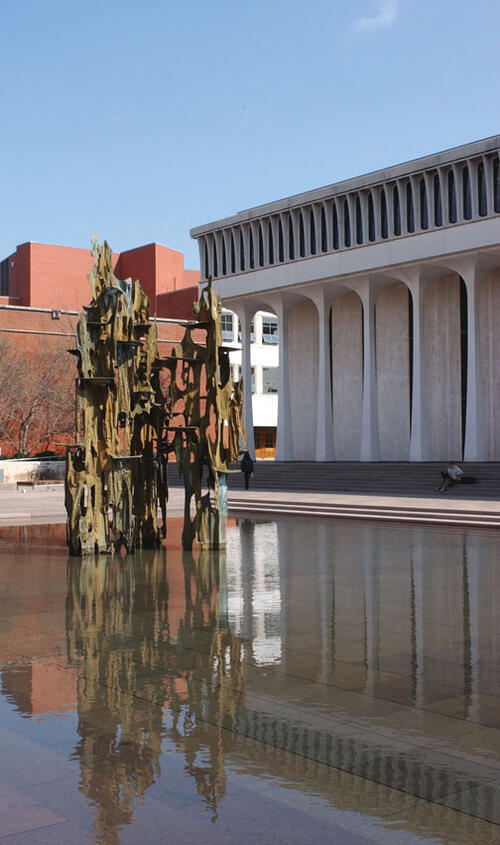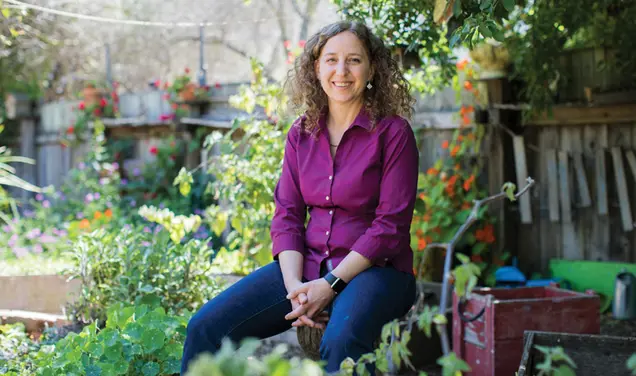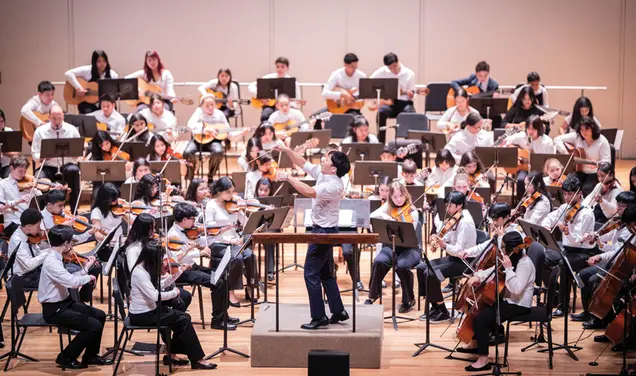Robertson lawsuit settled
University to have sole control of endowment; Robertson family foundations to receive $90 million
After a bitter legal struggle that had gone on for more than six years, it took a month for the University and the Robertson family to settle their dispute as a trial date loomed over the spending of Robertson Foundation funds in support of the Woodrow Wilson School.

As part of an agreement announced Dec. 10 and approved in New Jersey Superior Court Dec. 12, the Robertson Foundation, created with a $35 million gift to Princeton by A&P heiress Marie Robertson in 1961 to fund the graduate program of the Wilson School to train public servants, will be dissolved.
The foundation’s assets — which had grown to more than $900 million last June and were assumed after the economic downturn to be at least $700 million in December — will be transferred to a new restricted fund of the University called the Robertson Fund, which will continue the mission envisioned by the donor but will be controlled solely by the University.
The settlement came with a high price tag: Princeton will pay $90 million plus interest to private foundations controlled by the Robertson family. The University’s own legal fees and expenses in the case total more than $40 million. President Tilghman conceded that the agreement involves “a great deal of money,” but said she was “enormously pleased” with the outcome of the case.
She said Princeton had achieved its primary goal: “to preserve the right of the University to pursue the education of men and women for public and international service in the way that we believe that it should be done and has been done over the last 75-plus years.”
Proceeding with a trial that was anticipated to last six to nine months, as well as likely appeals, could have cost each side an additional $20 million in legal fees, Tilghman said.
William S. Robertson ’72, the lead plaintiff in the case and the son of Marie Robertson and her husband, Charles ’26, said the settlement was “a very, very worthy one” and that payments from the University “will provide us adequate funds to create a new nonprofit dedicated to the important government-service mission my parents designated in their 1961 gift.”
Tilghman and Peter McDonough, the University’s general counsel, stressed that the suit could have been settled earlier in the case on terms similar to those that finally were accepted. The settlement terms “were at least seven times less than what had been offered to us by the Robertsons at any time during the course of this long lawsuit,” McDonough said.
Both Tilghman and Robertson used the term “tragedy” in describing the litigation, but both said they stood by their actions.
“We feel no regret about acting precisely as we did,” said Robertson. “For many decades, University officials refused to honor their commitment to my parents, thereby dooming a powerful and patriotic program.”
Said Tilghman: “I cannot see that the University had any choice but to defend the Woodrow Wilson School in the way it did — aggressively, and with the conviction that the Woodrow Wilson School is one of the jewels in the Princeton crown.”
Seeds of the dispute were sown in the original agreement reached by Charles Robertson and then-President Robert F. Goheen ’40 *48 in creating the Robertson Foundation. The foundation’s seven-member board included four University representatives and three Robertson family designees, with Charles Robertson serving as board president from its inception until shortly before his death in 1981.
Tilghman said that the foundation concept works well “as long as the original donor is alive and can sit at the table and can express his intent clearly. ... This is precisely what Charles Robertson did for the years that he was alive after the foundation was created.” The problem arose after his death, she said, when William Robertson began representing the family’s interests “and began to reinterpret what his father’s intent was.”
Robertson, his sisters, and his cousin filed suit against Princeton in July 2002. As the foundation’s endowment approached $500 million, the board decided to seek professional management of the assets, rather than continue to rely on the volunteer work of three board members, including William Robertson. A move to retain Princo, which manages the University’s endowment, was strongly opposed by Robertson. He also contended that $22 million was spent on Wallace and Robertson halls without board authorization.
Robertson said in a PAW interview that the two issues could have been resolved “in a heartbeat” if the Univer-sity initially had tried to reach an accommodation. But Tilghman, in a separate interview, said the only way a suit could have been avoided was to continue use of a volunteer investment committee — and that, she said, “would have made the University vulnerable to a charge of fiscal irresponsibility.”
The Robertsons also claimed that the University was not taking seriously enough their parents’ goal of preparing students to work for the federal government, especially in international relations, and pressed to remove the entire foundation from Princeton and take it to another institution.

The case grew increasingly acrimonious; a court-ordered mediation attempt reached an impasse two years ago, and there was little hope for a settlement until a trial date of Jan. 20 was set last fall. Both sides were preparing for trial; the University purchased a building on Alexander Road near Route 1 and began outfitting it as a “war room” that could accommodate 30 lawyers, McDonough said.
The breakthrough in the case came after Robertson contacted Milbank, Tweed, Hadley & McCloy, a New York law firm that had represented his family, to open fresh talks with the University. That led to a meeting Oct. 22 between McDonough and Milbank Tweed partner David Gelfand, who outlined his expectations: Either the case would be resolved in two weeks, or he would “get out of the game.”
An ad hoc group of seven trustees had been set up in 2007 to work with Tilghman on the Robertson case. Now the group gave McDonough a set of negotiating parameters, and a “series of conversations” with Gelfand followed. The full board was to meet on Friday, Nov. 21, from 4 to 6 p.m. on the Robertson case, and McDonough had been expecting to discuss the trial preparations, which included the intention of Gen. David Petraeus *87 to testify on behalf of Princeton.
McDonough told Gelfand that he would need board approval of any settlement, and if a proposed agreement wasn’t ready to discuss with the trustees on Nov. 21, the board would not have another scheduled meeting until late January — after the trial was to begin in Trenton. With the last significant issues settled that Friday morning, McDonough said, the informal agreement was “solid enough” for the board that afternoon to approve continuing the talks.
Details continued to be worked out, including confirmation of the Robertsons’ legal costs. Former N.J. Gov. Thomas Kean ’57, the newest member of the foundation board and the only member not named in the litigation, reviewed the proposed settlement, decided that it was appropriate for the foundation to pay the Univers-ity’s legal expenses, and determined on behalf of the foundation that the agreement was a fair one. After the last documents were signed the evening of Dec. 9, the University announced the settlement at 9 a.m. the next day.
The settlement precluded a final judicial ruling in what was widely viewed as a test case for donors un-happy with how their charitable gifts were being used. McDonough said that because the Robertson Fund would continue to allocate funds consistent with the original gift, “donor intent has been preserved through this settlement.”
Robertson termed the agreement “more than a slap on the wrist” for Princeton. “Donors should continue to hope for and expect performance and cooperation from recipients, and we hope that this case has in some way contributed to that notion,” he said.
Tilghman said that while some press articles cast the University in a negative light, this had “remarkably little effect on the alumni,” noting that Annual Giving totals and participation rates have increased since the suit began.
Robertson praised several initiatives of Anne-Marie Slaughter ’80, who became Wilson School dean two months after the lawsuit was filed, and Tilghman cited the dean as well.
“I firmly believe that if Charles and Marie Robertson were alive today, they would take immense pride in what the school is doing, and they would consider Anne-Marie Slaughter their dream dean,” Tilghman said.
- Dissolution of the Robertson Foundation.
- Transfer of the foundation’s assets (assumed in December to be at least $700 million) to a new restricted fund of the University called the Robertson Fund, dedicated to support of the graduate program of the Woodrow Wilson School. The University will have sole control over the fund.
- Reimbursement by January 2011 of $40 million of Robertson family legal expenses.
- Payments totaling $50 million plus interest between 2012 and 2018 into a new charitable foundation created by the Robertsons to prepare college students for government service. If the payments are not prepaid by the University, the interest would total just over $10 million.
- Payment from Robertson Foundation funds of Princeton’s legal expenses in excess of the $16 million already paid by the University’s insurance carrier (estimated at $25 million).
- The payments listed above are permitted — and expected — to be made from Robertson Foundation assets.










1 Response
Richard Houck ’71
16 Years AgoCostly legal settlement
PAW did a masterful job of summarizing the Robertson v. Princeton settlement in four inches of ink (Notebook, Jan. 28). Both the administration and the Robertson family were “happy” with the settlement, both sides were convinced they were right and knew more than the original grantors (likely turning over in their graves), thus leading to the $80 million in legal expenses, most of which came out of foundation money. Wouldn’t one think that the administration and one of its graduates (William Robertson ’72), following the unofficial University motto of “Princeton in the nation’s service,” could have come to the same conclusions after a “liberal arts” conversation over dinner without having spent in legal fees more than twice the sum of the initial foundation endowment?
Couldn’t, and shouldn’t, that $80 million have been used for better purposes than to feed the families of lawyers? What is the lesson for graduates of the Wilson School to have learned: public service in international affairs, or a career in the legal profession? How could anyone have been “happy” with this result knowing what it cost, and what could have been done with that sum of money?